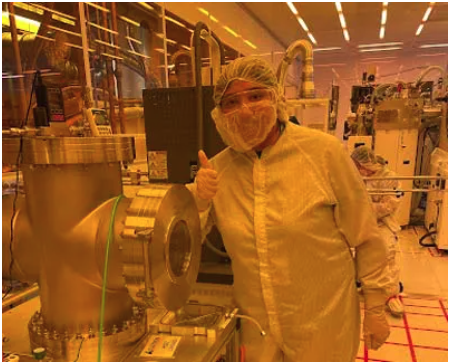Adapted from SJSU‘s Washington Square Magazine Spring 2024 issue

Danitza Hernandez, ’25 Materials Engineering, could hardly believe it: just two years ago, she’d been sleeping in a restaurant next to a grease trap while attending community college, and now here she was, working in the prestigious Lawrence Berkeley National Laboratory on a project funded by the U.S. Department of Energy. Here she was, in a clean room in full gear (including a suit, hairnet, mask and gloves) cutting silicon wafers and spin coating them with polypeptoids in order to help make electronic chips smaller and more efficient.
She describes the experience as “very surreal.” It all began with her transfer from community college to SJSU and a peer program at the Engineering Student Success Center that led to work in Dahyun Oh’s lab. Oh, an associate professor of chemical and materials engineering, started Hernandez on basic tasks, but soon Hernandez’s interests and knowledge grew. She studied electrochemistry through YouTube videos and learned materials characterization (the creation of materials needed for things like semiconductors and electronics) through her work in the lab.
From there, she was selected as a student scholar in the Energy Frontier Research Center for High Precision Patterning Science (CHiPPS) program, which is funded by the Department of Energy and involves six institutions: Berkeley Lab, Stanford University, Cornell University, Argonne National Laboratory, UC Santa Barbara and San José State University. The center’s mission is to “create fundamental understanding and control of patterning materials and processes for energy-efficient, large-area patterning with atomic precision.”
Interested in Becoming a Foundry User?
Join our collaborative, multidisciplinary environment.
Learn more >
At first, Hernandez worked with the program through Oh’s lab at SJSU, but Oh also encouraged her to apply to the CHiPPS summer program.
The ChiPPS student scholar program began in summer 2023 as a training program connected to the CHiPPS center that allowed students from SJSU to intern at Berkeley Lab for ten weeks, pairing them with a scientist mentor to work on advanced semiconductor manufacturing skills. Participants received stipends of $7,000 for undergrads and $8,000 for graduate students upon completion of the program. Hernandez was hesitant to apply because of her lack of experience. “I was just an undergrad and when I thought of going to a national lab, I just thought, ‘I can’t do that,’” she says. “But thankfully, Dr. Oh encouraged me. It took a lot of hand-holding to even get me to submit the application.”
But submit she did. And she told her story: “I mentioned how even just doing the summer program would just be another sign that my life is changing for the better,” she remembers. “Going from living in a restaurant next to a sink to waking up in an actual bed and getting up and going to an actual work environment is very mind-blowing.” She got in.
Hernandez focused on patterning, cutting and cleaning the silicon wafers involved in computer chips and then baking them with various solutions in order to begin the process of creating a smaller, more efficient chip.
Hernandez really enjoyed the work, even though it was difficult. “The people who were around me gave me a lot of interesting options that I didn’t know were possible,” she says. She’d assumed that getting a PhD in materials engineering meant teaching, which she wasn’t interested in, but they told her that she also could use a PhD to do research or work in a lab, opening up a new realm of possibilities for her future.
“I’m very thankful for Dr. Oh,” she says. “I struggle a lot with imposter syndrome, and she’s been my mentor ever since I met her. She’s been very supportive, very understanding. And I thought it was just her, but I found that same kind of heart in the people at LBL, even with people who weren’t in my research group.”
She urges other students like her, who may feel like they don’t have enough experience to work in a national lab, to fill out an application anyway. “It’s not just you who’s feeling this,” she tells them. “It’s other people, too, who feel out of place in the scientific community. But you could be that mentor later on to people who look like you, people you don’t really see in these science research facilities.”
Read the full article

